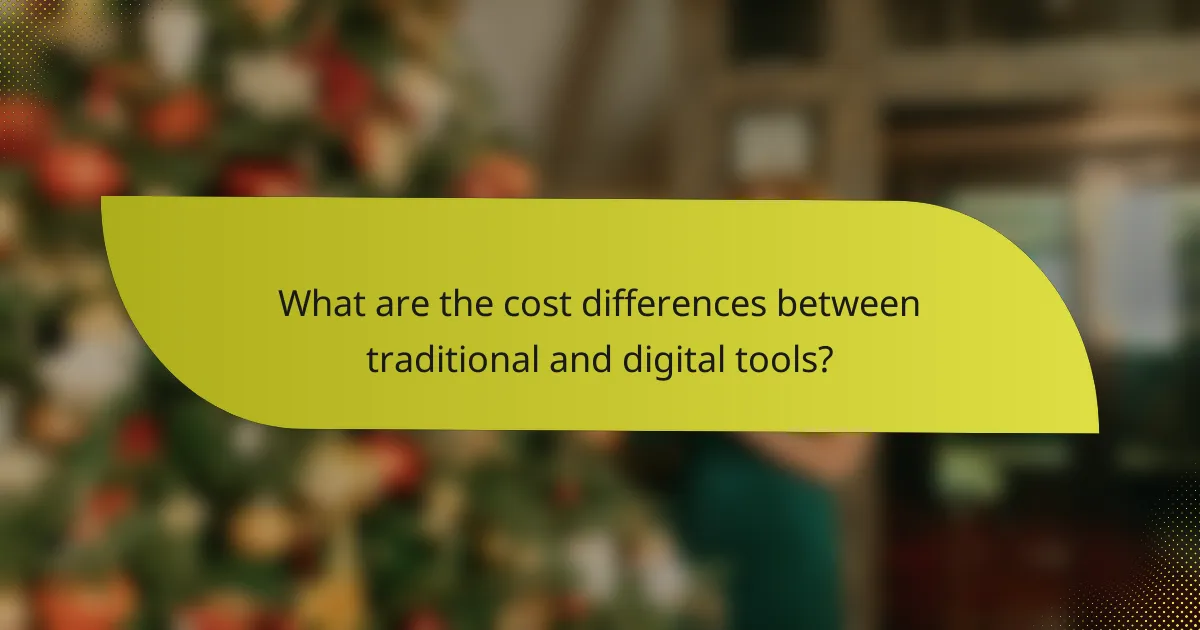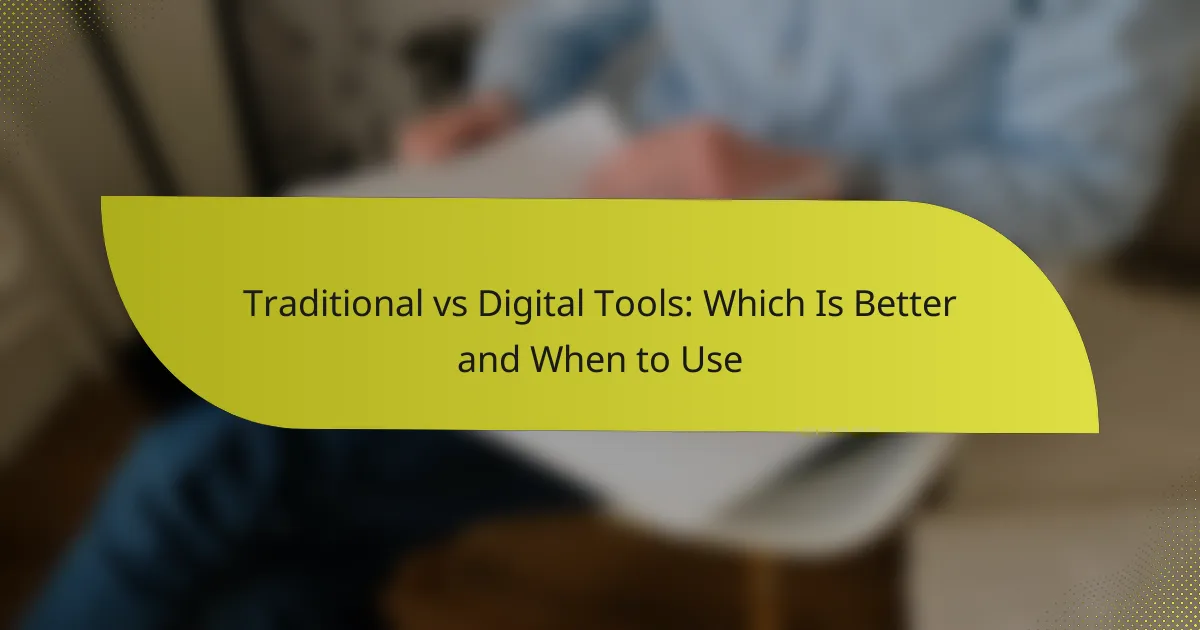The debate between traditional and digital marketing tools is ongoing, with each method offering unique advantages depending on the context. Traditional tools can be particularly effective for local targeting and engaging older audiences, while digital tools excel in reaching larger, younger demographics and providing real-time insights. Understanding when to use each approach is crucial for maximizing campaign effectiveness and achieving desired outcomes.

Which tools are more effective for marketing in New York?
In New York, both traditional and digital marketing tools can be effective, but their impact varies based on the target audience and campaign goals. Traditional tools like print ads may resonate more with certain demographics, while digital tools such as social media offer broader reach and engagement opportunities.
Traditional tools like print ads
Traditional marketing tools, such as print ads, can be effective in reaching specific local audiences in New York. For example, ads in local newspapers or magazines may capture the attention of residents who prefer tangible media over digital formats.
When using print ads, consider the placement and timing. Ads in high-traffic areas or during local events can enhance visibility. However, be mindful of costs, as print advertising can be expensive, often requiring a budget in the low thousands of USD for a single campaign.
Digital tools like social media
Digital tools, particularly social media platforms, are increasingly popular for marketing in New York due to their ability to target specific demographics and track engagement. Platforms like Instagram and Facebook allow businesses to reach a wide audience quickly and at a lower cost compared to traditional methods.
To maximize effectiveness, create engaging content that resonates with your audience. Utilize analytics tools to monitor performance and adjust strategies accordingly. Remember, while digital marketing can be cost-effective, it requires ongoing effort and adaptation to trends, which can change rapidly in a dynamic market like New York.

When should you use traditional tools?
Traditional tools are best used in scenarios where personal interaction and tactile experiences are essential. They often excel in local targeting and when engaging with older demographics who may prefer familiar methods over digital alternatives.
For local targeting
Traditional tools such as flyers, posters, and local newspaper ads are effective for reaching specific communities. They allow businesses to connect directly with local consumers, making it easier to convey messages that resonate with regional values and preferences.
Consider using direct mail campaigns to target neighborhoods or local events to engage potential customers. This approach can yield higher response rates, especially when combined with community involvement or sponsorships.
For older demographics
Older demographics often favor traditional tools like print media and face-to-face interactions. Many individuals in this age group may find digital platforms challenging or less trustworthy, making familiar methods more appealing.
When marketing to older audiences, consider using brochures, direct mail, and local community events. These methods can foster trust and provide a personal touch that resonates with this demographic, enhancing engagement and response rates.

When should you use digital tools?
Digital tools are best utilized when you need to enhance efficiency, reach a larger audience, or engage with younger demographics. They offer capabilities that traditional tools may lack, such as real-time data analysis and broader distribution channels.
For broader reach
Digital tools allow you to connect with a global audience, breaking geographical barriers that traditional methods cannot. For instance, social media platforms can help you reach thousands or even millions of users instantly, compared to local flyers or print ads.
Consider using email marketing, social media campaigns, or online advertising to maximize your outreach. These methods can often yield higher engagement rates, with some studies suggesting that digital outreach can be several times more effective than traditional methods.
For younger audiences
Younger audiences tend to favor digital communication, making digital tools essential for engaging this demographic. Platforms like Instagram, TikTok, and Snapchat are particularly popular among younger users, providing unique ways to connect through visuals and interactive content.
To effectively reach younger audiences, focus on creating engaging and shareable content. Use analytics to track engagement and adapt your strategies based on what resonates most with this group. Avoid overly formal communication styles, as authenticity is key in appealing to younger users.

What are the cost differences between traditional and digital tools?
The cost differences between traditional and digital tools can vary significantly based on initial investment, ongoing expenses, and flexibility in budgeting. Traditional tools often require a larger upfront investment, while digital tools can provide more adaptable financial options over time.
Traditional tools often have higher upfront costs
Traditional tools typically involve substantial initial costs due to the need for physical materials, equipment, and sometimes specialized training. For instance, purchasing high-quality drafting tools or manual machinery can range from hundreds to thousands of dollars, depending on the complexity and brand.
Additionally, maintenance and replacement costs can add to the overall expense. Users should consider these factors when budgeting for traditional tools, as they may need to allocate funds for repairs or upgrades over time.
Digital tools offer flexible budgeting options
Digital tools generally provide various pricing models, including subscriptions, one-time purchases, or pay-per-use options. This flexibility allows users to choose a plan that fits their budget and needs, often starting from as low as a few dollars per month for basic software.
Moreover, many digital tools offer free trials or freemium versions, enabling users to test functionality before committing financially. This can be particularly advantageous for startups or individuals looking to minimize expenses while still accessing essential resources.

How do engagement rates compare?
Engagement rates for digital tools are generally higher than those for traditional tools, largely due to the interactive nature of digital platforms. Users can engage in real-time, leading to more immediate feedback and participation.
Higher engagement with digital tools
Digital tools often facilitate higher engagement through features like instant messaging, social media interactions, and multimedia content. For instance, platforms such as Instagram or Twitter allow users to comment, share, and react instantly, which can boost interaction rates significantly.
Additionally, analytics tools can track user behavior, providing insights that help tailor content to audience preferences. This data-driven approach can lead to a more engaged user base, as content can be adjusted based on what resonates most with the audience.
Lower engagement with traditional tools
Traditional tools, such as print media or face-to-face meetings, typically see lower engagement rates because they lack the immediacy and interactivity of digital options. For example, a printed newsletter may only reach a fraction of its audience, and feedback is often delayed.
Moreover, traditional methods can be less appealing to younger audiences who are accustomed to the fast-paced nature of digital communication. This disconnect can result in lower participation rates and less effective outreach.

What are the benefits of combining both tools?
Combining traditional and digital tools offers a range of benefits, including broader audience engagement and enhanced credibility. By leveraging the strengths of both mediums, businesses can create a more effective marketing strategy that reaches diverse demographics and builds trust with consumers.
Increased overall reach
Utilizing both traditional and digital tools can significantly expand your overall reach. Traditional methods like print ads, billboards, and direct mail can engage audiences who may not be active online, while digital platforms such as social media and email marketing can connect with tech-savvy consumers.
For example, a local business might use flyers to attract nearby customers while simultaneously running a targeted social media campaign to reach a broader audience. This dual approach allows for a more comprehensive marketing strategy that captures various segments of the market.
Enhanced brand credibility
Combining traditional and digital tools can enhance brand credibility by showcasing a professional and well-rounded presence. Consumers often perceive brands that utilize multiple channels as more trustworthy and established.
For instance, a company that advertises in local newspapers while maintaining an active online presence can reinforce its reliability. This strategy can help build consumer confidence, as potential customers see consistent messaging across different platforms.

What criteria should you consider when choosing tools?
When selecting between traditional and digital tools, consider factors such as your target audience, budget constraints, and the specific context of use. Each criterion can significantly influence the effectiveness and efficiency of the tools you choose.
Target audience demographics
Understanding your target audience demographics is crucial when choosing tools. Different age groups and cultural backgrounds may have varying preferences for traditional versus digital tools. For example, younger audiences may be more inclined towards digital solutions, while older generations might prefer familiar, traditional methods.
Consider conducting surveys or focus groups to gather insights about your audience’s preferences. Tailoring your approach based on demographic insights can enhance engagement and effectiveness.
Budget constraints
Budget constraints play a significant role in the decision-making process for selecting tools. Traditional tools often involve upfront costs for materials and supplies, while digital tools may have subscription fees or one-time purchases. Assess your budget to determine which option provides the best value for your needs.
It’s essential to weigh the long-term costs against the initial investment. For instance, while digital tools might seem expensive initially, they can save money over time through efficiency and reduced material costs. Create a budget plan that includes both short-term and long-term expenses to make an informed choice.
